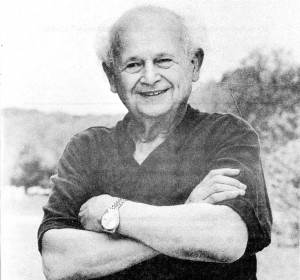The work is in part based on the work of the renowned scientist, Dr. Moshe Feldenkrais. His work in Functional Integration and Awareness Through Movement is groundbreaking, and integrates neuro-skeletal movements to provide often immediate and dramatically visible positive results throughout the central nervous system. The method affects many levels simultaneously, making inroads for injury rehabilitation more possible, creates new neuro-pathways in the brain for new learning and a renewed sense of self.
How It Works
The movements retrain the brain for learning, are relaxing in allowing you to acquire more awareness, patience, flexibility and coordination as you revive your nervous system from the inside out. The work is endorsed by physicians, scientists and academicians worldwide. Some references to academic work are in the Learning section, with ongoing updates. Neuroscientist Karl Pribram said ” He is not just pushing muscles around, he’s changing things in the brain itself so that the person can gradually adjust…to what we call a normal image…of achievement.”
The sections on Bones For Life, Brain Games, Phobease, and Yoga incorporate principles of the Feldenkrais Method for applications in different categories. Dr. Feldenkrais has said, “Movement is life. Without Movement life is unthinkable. The goal of the movements is to make the impossible possible, the possible easy, and the easy elegant.”
A Brief Description for the Helping Professions
written by
Carl Ginsburg. PH.D.
The key to awareness and to reorganization is learning, and it is through the understanding of the human learning process that Dr Feldenkrais and the practitioners he has trained have succeeded so well in teaching so many people. Basic to his teaching method is an understanding by Feldenkrais of the human person as a complete being, involving mind heart and body. Feldenkrais has shown in his work that when one properly understands the cybernetic principles with which we all operate, then each of us is capable of enormous powers of self-correction, learning, and self healing.
The consequences of such learning are manifold. For those in pain or discomfort, there is a reduction or more often a disappearance of the pain or discomfort. Tissues such as joints, spinal discs, ligaments, muscles or tendons previously stressed by misuse are no longer irritated and are thereby in a new situation where healing can take place. Persons locked into body positions from habitual use can discover the freedom to find new positions and new energy. Effort changes to ease as a person learns to use the center of the body for large movement and the extremities for fine coordination.
The effect of the Feldenkrais method in chronic pain situations has been recently documented by Thomas Hanna in his book, “The Body of Life” (Alfred A, Knopf, 1980) and by Yochanan Rywerant (Somantics, 1977, Vol.1, no.2 p.37). Feldenkrais illustrates his teaching-healing process in his book “The Case of Nora “(Harper & Row, 1977), where his teaching and his students learning led to the recovery of the functions of reading and writing after a cerebral accident. Yochanan Rywerant has also reported an instance in which the Feldenkrais way of teaching has resulted in the recovery of function after severe nerve damage (Somantics. 1979, Vol.2, no.3 p,26). In this case, Rywerant was able to help a concert flutist who lost use of his hand as a result of gunshot wound to the median nerve. The flutist not only was able to play again but also was able to resume his career.
Health and Movement
Self-responsibility and self-healing are new themes in the health professions along with the beginnings of some understanding of the way lifestyle and stress affect our life process, and the ability to live a fulfilled and healthy life. Dr Moshe Feldenkrais sees movement and the organization of movement as a key to understanding the relation of lifestyle, self-organization and health.
But even more important, Dr Feldenkrais sees the reorganization of movement as a pathway to the kind of self-reorganization which results in the ability to lead a more healthy, stress adaptable, fulfilled and efficient life. To this end he has spent the last forty years of his life developing a teaching based on awareness to help people learn to use themselves in less destructive and thereby more healthy ways.
Awareness
Awareness in this context means a somatosensory knowing, an expansion thereby of the self-image and self-possibilities so that the person feels and knows what he or she does in the act of doing. Feldenkrais has consistently maintained over the years that each of us is capable of far more than we even imagine for ourselves. The achievement of this capability through awareness also leads to the inhibition of useless muscular effort in all action, the reorganization of the musculature and therefore the skeletal and connective tissue structure in the gravity field, and the reduction of general body tension in all positions from lying to sitting to standing. At the acme of awareness and self-reorganization, a person is free to find that centered place in gravity from which he or she can move to any new place without rearrangement.
The Function Concept
The success of the Feldenkrais method in teaching people in so many diverse situations is based upon a particular understanding of the human body in terms of its interrelationships in movement and action. These interrelationships are brought into awareness through specific movement lessons taught in “Awareness Through Movement” classes and workshops or through individual hands-on lessons in “Functional Integration”. Underlying these methods is the concept of function, a unique contribution by Dr. Feldenkrais to the understanding of the workings of the human system. Function in the Feldenkrais way is a cybernetic notion in which the ability of each part to move is seen in relation to a complete unified action or function. A healthy action 0f function is one in which all parts of the self contribute synergistically to a smooth reversible efficiency in action and movement.
Disturbances in function are seen then as responsible for stresses to parts of the system that eventually result in pain and inability. Feldenkrais practitioners are specifically trained to work with and understand function in this sense, and in their teaching lead clients to an integration of a function as a complete sensory and spatial image, working from foot to head. Neurologically this process corresponds to what Stanford neurophysiologist Karl Pribram calls the formation of an image of achievement, and fits with the more cybernetic models of neurological functioning as developed by Pribram, A.R. Luria, and others.
Awareness Through Movement ®
The two teaching methods developed by Dr. Feldenkrais present two sides of the same process. Awareness Through Movement is a group teaching method in which students increase awareness through self-exploration within the framework of structured movement sequence.
This method has been used, for example, in the clinic of a large southwestern corporation to help patients with back pain, gain freedom of movement, body awareness, and the ability to relax and breathe freely with remarkably better success at putting these patients in control of their problem than other back programs.
Functional Integration ®
Functional integration is a unique, nonverbal teaching method in which the practitioner’s hands guide the client to greater awareness and self-image. This method is indicated when a person needs added input to the nervous system beyond what can be achieved with self-exploration and where there is pain or other disability. It is an extremely gentle method (no force is ever used) and thereby surprising in its effectiveness.
When Is Feldenkrais Work Indicated?
Both methods can be useful to people in many situations. To those caught in maladaptive ways of moving, being and Standing, Feldenkrais one of the most efficient ways of discovering new patterns and discarding old ones. Included can be people with neuromuscular difficulties, chronic pain, injuries, etc., as well as many persons simply wishing to expand their capabilities and self-possibilities.
Dr. Feldenkrais, himself, has taught actors, dancers, children with cerebral palsy or with learning disabilities, stroke victims and paraplegics, musicians and athletes. In severe trauma the Feldenkrais method can be a pathway to functional recovery as contrasted to the usual rehabilitation through compensation.
Since Feldenkrais practitioners are trained to work with whole patterns, they can often deal with the disturbances in self-organization resulting from accident and injury often missed by other practitioners concerned more with the specific injury. The possibilities of the Feldenkrais method have just begun to be explored.
For Information
Catherine Thomas certified Feldenkrais practitioner with 30 years of experience in Movement Education. She teaches Awareness Through Movement and practices Functional Integration (as well as Bones for Life) in Northern California. For further information, call or write
Cate Thomas
707-578-3377
catethomas3@yahoo.com
“Feldenkrais is not pushing muscles around, but changing things in the brain itself so that their person can gradually adjust to what we call a normal image of achievement.”
Karl Pribram, MD, PhD.
Neuroscientist



